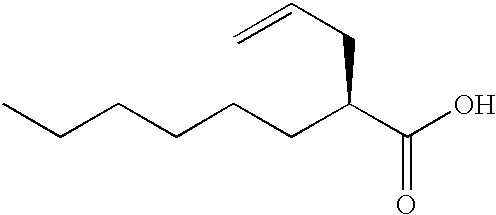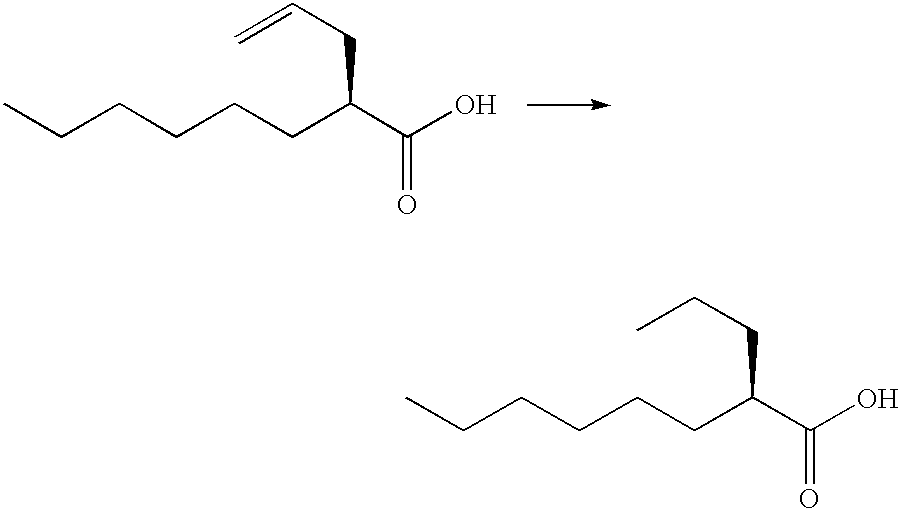Process for the preparation of (2R)-2-propyloctanoic acid
a technology of propyloctanoic acid and process, which is applied in the direction of physical/chemical process catalysts, metal/metal-oxide/metal-hydroxide catalysts, fatty-oils/fat refining, etc., can solve the problem of dangerous unexpected side effects and achieve the effect of high optical purity
- Summary
- Abstract
- Description
- Claims
- Application Information
AI Technical Summary
Benefits of technology
Problems solved by technology
Method used
Image
Examples
reference example 2
(2S)-2-(2-propenyl)octanoic acid
##STR2##
n-Hexane / ethyl acetate (4 / 1; 2790 ml) and 2N hydrochloric acid (270 ml) were added to the compound prepared in Reference example 1 (140 g), and the mixture was stirred for 30minutes. The water layer was removed from there action solution, and the organic layer was washed with water (690 ml.times.3 times), and the product was extracted with 2.6N sodium hydroxide (750 ml). The water layer was washed with n-hexane / ethyl acetate (4 / 1; 2790 ml.times.2 times). To the water layer, 2N hydrochloric acid (990 ml) was added, and the product was extracted with n-hexane / ethyl acetate (4 / 1; 2790 ml). The organic layer was washed with water (690 ml.times.3 times) and with a saturated aqueous solution of sodium chloride, and concentrated to give the title compound (89 g; yield 98%). Optical purity (measured by gas chromatography): 99.8% e.e.
example 1
Preparation of (2R)-2-propyloctanoic acid Using Platinum on Carbon
##STR3##
A solution of the compound prepared in Reference example 2 (87 g) in 2-propylalcohol (2.17 L) was added to 5% platinum on carbon (44 wet %) (9.91 g), and the mixture was hydrogenated under a pressure of hydrogen (5 kg / cm.sup.2), at 30.degree. C. for 4 hours. The reaction mixture was filtered, and the filtrate was concentrated. To the residue, n-hexane / ethyl acetate (5 / 1; 1.7 L) was added, and the product was extracted with 2N sodium hydroxide (511 mL). A concentrated hydrochloric acid (86 ml) was added to the water layer, and the product was extracted with n-hexane / ethyl acetate (5 / 1; 1.7 L). The organic layer was washed with purified water (430 ml.times.3 times), a saturated aqueous solution of sodium chloride, dried and concentrated. The residue was distilled to give the title compound (75.0 g; yield: 85%) having the following physical data. Optical purity (measured by HPLC): 99.4% e.e.
example 2
Preparation of (2R)-2-propyloctanoic acid Using Platinum on Carbon
##STR4##
5% Platinum on carbon wet (270 g) was added to a solution of (2S)-2-(2-propynyl)octanoic acid (described in JP-A-8-291106) (43.0 kg; 99.90% e.e.) in isopropylalcohol (344 L), and the mixture was hydrogenated under a pressure of hydrogen (3.9.about.15.0 kg / cm.sup.2), at 20.about.30.degree. C. for 8 hours. Similarly, 5% platinum on carbon wet (149 g) was added to a solution of (2S)-2-(2-propynyl)octanoic acid (23.7 kg; 99.90% e.e.) in 2-propylalcohol (190 L), and the mixture was hydrogenated under a pressure of hydrogen (2.6.about.15.0 kg / cm.sup.2), at 16.about.30.degree. C. for 5 hours. A catalyst was removed from the above two reaction solutions. These filtrates were concentrated. The residue was distilled to give the title compound (56.48 kg; yield: 82.8%) having the following physical data. Optical purity (measured by HPLC): 99.34% e.e.
PUM
| Property | Measurement | Unit |
|---|---|---|
| Fraction | aaaaa | aaaaa |
| Fraction | aaaaa | aaaaa |
| Fraction | aaaaa | aaaaa |
Abstract
Description
Claims
Application Information
 Login to View More
Login to View More - R&D
- Intellectual Property
- Life Sciences
- Materials
- Tech Scout
- Unparalleled Data Quality
- Higher Quality Content
- 60% Fewer Hallucinations
Browse by: Latest US Patents, China's latest patents, Technical Efficacy Thesaurus, Application Domain, Technology Topic, Popular Technical Reports.
© 2025 PatSnap. All rights reserved.Legal|Privacy policy|Modern Slavery Act Transparency Statement|Sitemap|About US| Contact US: help@patsnap.com



